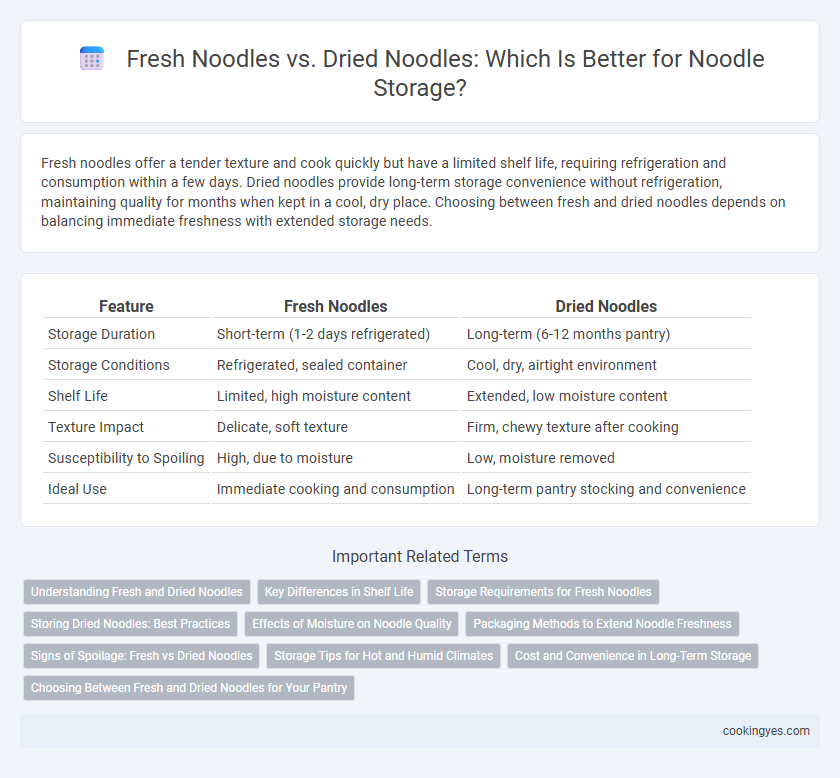Fresh noodles offer a tender texture and cook quickly but have a limited shelf life, requiring refrigeration and consumption within a few days. Dried noodles provide long-term storage convenience without refrigeration, maintaining quality for months when kept in a cool, dry place. Choosing between fresh and dried noodles depends on balancing immediate freshness with extended storage needs.
Table of Comparison
| Feature | Fresh Noodles | Dried Noodles |
|---|---|---|
| Storage Duration | Short-term (1-2 days refrigerated) | Long-term (6-12 months pantry) |
| Storage Conditions | Refrigerated, sealed container | Cool, dry, airtight environment |
| Shelf Life | Limited, high moisture content | Extended, low moisture content |
| Texture Impact | Delicate, soft texture | Firm, chewy texture after cooking |
| Susceptibility to Spoiling | High, due to moisture | Low, moisture removed |
| Ideal Use | Immediate cooking and consumption | Long-term pantry stocking and convenience |
Understanding Fresh and Dried Noodles
Fresh noodles contain higher moisture content, making them more perishable and requiring refrigeration, while dried noodles have most of their moisture removed, allowing for long-term storage at room temperature. The texture of fresh noodles is softer and more tender, offering a different culinary experience compared to the firm, chewy consistency of dried noodles after cooking. Understanding these differences helps in choosing the appropriate noodle type based on storage conditions, shelf life, and desired dish quality.
Key Differences in Shelf Life
Fresh noodles have high moisture content, limiting their shelf life to just a few days under refrigeration, typically 2 to 3 days. Dried noodles undergo dehydration, reducing moisture to below 12%, enabling storage at room temperature for months, often up to one year. This key difference in moisture levels directly impacts their longevity and storage requirements, making dried noodles more shelf-stable compared to fresh noodles.
Storage Requirements for Fresh Noodles
Fresh noodles require refrigeration at temperatures between 32degF and 41degF to maintain their moisture content and prevent microbial growth, typically lasting up to 2-3 days. They should be stored in an airtight container or tightly sealed packaging to avoid exposure to air and moisture, which can accelerate spoilage. Proper storage of fresh noodles is crucial to preserve their texture and flavor, unlike dried noodles which can be kept at room temperature for months.
Storing Dried Noodles: Best Practices
Dried noodles offer superior shelf life compared to fresh noodles, making them ideal for long-term storage. Store dried noodles in a cool, dry place away from direct sunlight, maintaining a consistent temperature below 70degF (21degC) to preserve texture and flavor. Using airtight containers can prevent moisture absorption and insect infestation, extending the noodles' usability for up to two years.
Effects of Moisture on Noodle Quality
Fresh noodles contain higher moisture content, typically around 30-40%, which contributes to their soft texture but short shelf life due to increased susceptibility to microbial growth and spoilage. Dried noodles, with moisture levels below 12%, offer extended storage stability by inhibiting bacterial activity and enzymatic reactions while maintaining firmness after cooking. Controlling moisture content is crucial for preserving noodle quality, as excessive moisture accelerates degradation, whereas low moisture ensures prolonged durability and consistent texture.
Packaging Methods to Extend Noodle Freshness
Vacuum sealing fresh noodles significantly reduces oxygen exposure, slowing spoilage and extending shelf life compared to traditional packaging. Dried noodles benefit from moisture-proof, airtight packaging materials such as plastic films or foil laminates to prevent humidity absorption and maintain texture. Controlled atmosphere packaging with inert gases further preserves both fresh and dried noodles by inhibiting microbial growth and oxidation.
Signs of Spoilage: Fresh vs Dried Noodles
Fresh noodles exhibit signs of spoilage such as a sour odor, slimy texture, and discoloration within a few days of refrigeration due to higher moisture content. Dried noodles, with low moisture levels, typically resist spoilage longer but show spoilage through mold growth, off smells, or brittle, powdery spots when exposed to moisture or prolonged storage. Proper storage conditions like airtight containers and cool, dry environments significantly extend the shelf life of both fresh and dried noodles.
Storage Tips for Hot and Humid Climates
Fresh noodles require refrigeration and have a short shelf life of 2 to 3 days, making them less ideal for hot and humid climates without consistent cooling. Dried noodles, with their low moisture content, can be stored at room temperature for several months, provided they are kept in airtight containers away from heat and humidity. To maintain quality in hot climates, store dried noodles in a cool, dry place and use vacuum-sealed bags or moisture-absorbing packets to prevent mold and spoilage.
Cost and Convenience in Long-Term Storage
Fresh noodles offer superior taste and texture but require refrigeration or freezing, increasing storage costs and limiting convenience for long-term storage. Dried noodles have a longer shelf life, do not require refrigeration, and are more cost-effective for bulk storage, making them ideal for extended periods. Choosing dried noodles reduces spoilage risk and simplifies inventory management, optimizing both cost and convenience in long-term storage.
Choosing Between Fresh and Dried Noodles for Your Pantry
Fresh noodles contain higher moisture content, making them more perishable and requiring refrigeration for short-term storage, typically lasting up to a week. Dried noodles undergo dehydration, allowing them to be stored at room temperature for months or even years without spoiling, ideal for long-term pantry use. Selecting between fresh and dried noodles depends on your convenience needs and recipe requirements, as fresh noodles offer a softer texture while dried noodles provide extended shelf life and versatility.
Fresh noodles vs Dried noodles for storage Infographic

 cookingyes.com
cookingyes.com